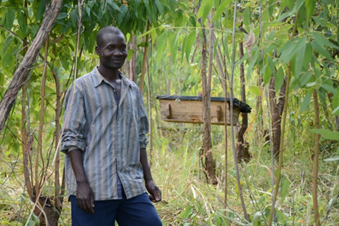
July 2014—On the edge of the Zomba plateau in southern Malawi, just as the land begins to slope up into an imposing peak, is a pretty patch of land covered with indigenous forests. Past the grass and into the trees there are signs of a careful intervention: a small irrigation canal and a meticulously kept stone wall. A few hundred bees are buzzing.
Lucius Simon is a beekeeper and irrigation farmer in the Lingoni watershed who is enthusiastic about his bees. “The number of hives are growing and providing income for me and my village,” he says. “More and more people are watching the bees now.”
When USAID’s Wellness and Agriculture for Life Advancement project was introduced in the area in 2012, before any bees lived in the forest reserve, Simon began working with the project on ways to preserve Malawi’s natural resources while generating income. That’s when he saw an opportunity.
“I built one beehive and put wax in it to attract the bees. The bees came. Now people cannot set the forest on fire or cut down the trees because we all benefit from assets in the forest,” says Simon.
He sells half a liter of his honey for 1,500 Malawian kwacha, or about $3.75. At harvest, which happens three times a year, each hive produces 15 liters of honey. That means an additional income of about $113 per year in a country where the average annual income is $270.
Malawians traditionally rely heavily on charcoal as a source of fuel. Indiscriminate burning of trees to make charcoal has devastated the indigenous forests and decreased the soil quality in neighboring farmland. Unfortunately, cutting back on charcoal use often means depriving families of their livelihoods.
The USAID Wellness and Agriculture for Life Advancement project, which began in 2009 and ends in July 2014, was designed to address situations like these throughout Malawi. Instead of focusing solely on one sector, an activity in one community includes interventions in multiple areas: health and nutrition, economic growth, and agriculture and environment. In the Lingoni watershed, the activity needed to provide an alternate source of income, promote sustainable and productive agricultural practices, and preserve natural resources. It’s a tall order, but Simon’s beehives are proof that it can be done.
Over the past three years, the number of beekeepers in this watershed has grown to 11 men and one woman, all irrigation farmers and participants in one of the project’s Village Savings and Loans groups. The self-selected group of about 20 community members is a kind of mini-bank.
Group members agree on an interest rate at the beginning of the year and can take out loans as they need. At the end of the year, the group divides the profits that the interest has generated between its members. So when it’s time to add a new beehive, which costs 5,000 Malawian kwacha, or about $12, Simon takes out a loan, buys the needed supplies, and then pays the Village Savings and Loans group back with interest. The group plans to continue buying hives via loans until each beekeeper has his or her own. They’re almost there: The group started with six hives. They now have 11.
The USAID project’s integrated approach has given Simon a new career, more abundant crops and a good return on investment. The forests are preserved and, it seems, the bees are happy, too.







Comment
Make a general inquiry or suggest an improvement.